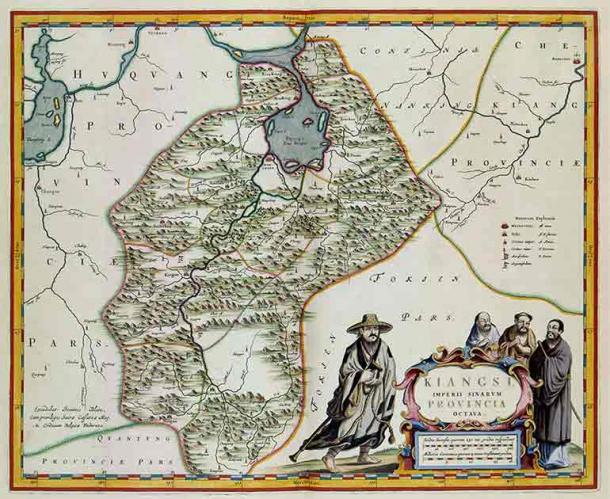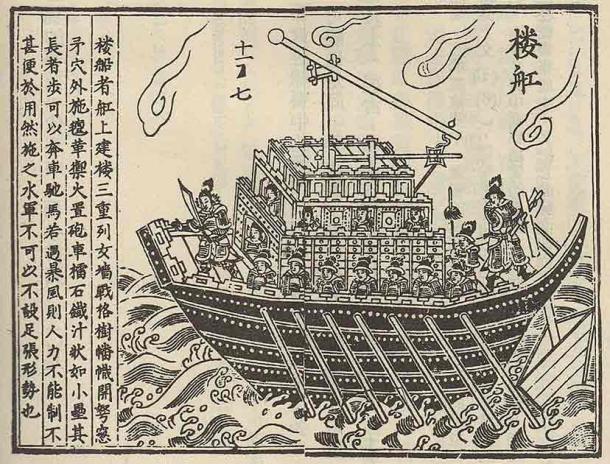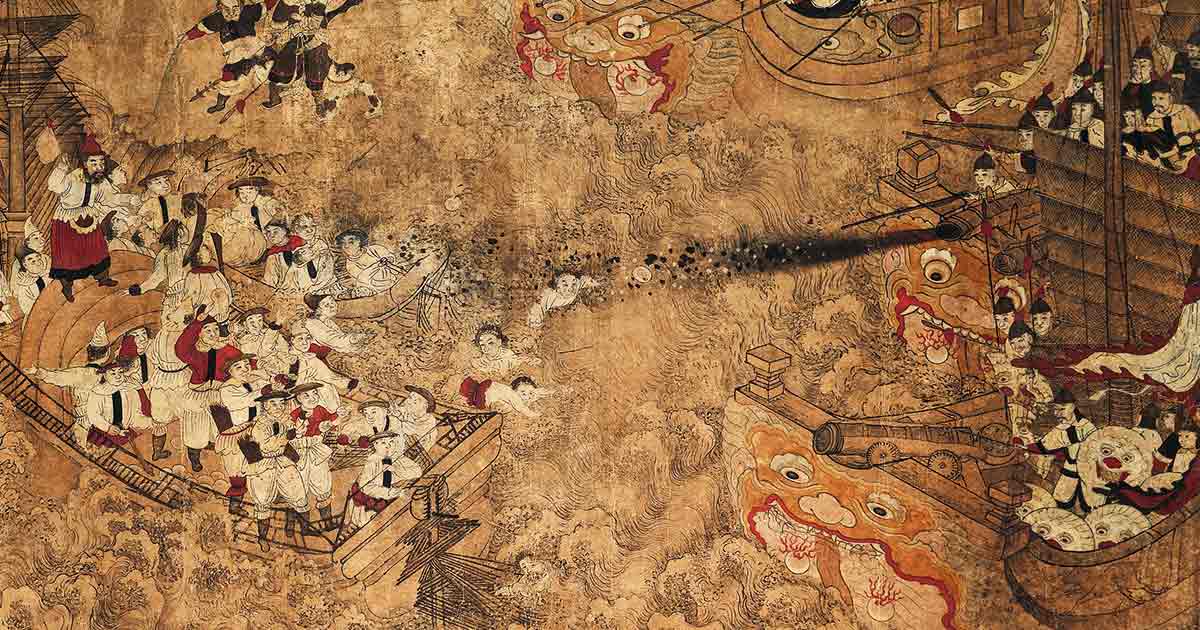The Battle of Lake Poyang and Its Pivotal Impact on China
The Battle of Lake Poyang stands as one of the largest naval engagements in recorded history, showcasing the might and strategic prowess of warring factions during the tumultuous period of the rise of the Ming Dynasty in Medieval China. Spanning from late August to early October in the year 1363 AD, this monumental clash took place on the vast expanse of Lake Poyang, situated in present-day Jiangxi Province.
A pivotal moment in the struggle for supremacy between the Ming Dynasty and the remnants of the Mongol-led Yuan Dynasty, this conflict was led by Zhu Yuanzhang against Chen Youliang's forces. In many ways, it was this battle that changed the course of medieval Chinese history.

Pavilions, terraces, and towers rise from the waters of Poyang Lake in China, marking the historic site of the Battle of Lake Poyang, a pivotal naval conflict in medieval Chinese history. (HAIYAN / Adobe Stock)
The Battle of Lake Poyang as the Culminating Point of the Red Turban Rebellion
The backdrop to the Battle of Lake Poyang was a complex web of political intrigue, shifting alliances and power struggles, known as the Red Turban Rebellion. Zhu Yuanzhang, a former Buddhist-monk-turned-military leader, had risen through the ranks of the Red Turban Rebellion, a movement aimed at toppling the foreign, Mongol-based Yuan Dynasty and restoring Han Chinese rule. Chen Youliang, on the other hand, had established himself as a formidable warlord in the chaos following the collapse of the Yuan Dynasty, seeking to carve out his own realm in southern China.
- A Centenary Of Modern Naval History 1616 to 1716
- Greek Fire Is Every Sailor's Deadly Nightmare (Video)
The Battle of Lake Poyang unfolded against the backdrop of the Yangtze River Basin, with Lake Poyang serving as a strategic chokepoint in the region. Zhu Yuanzhang, recognizing the importance of naval superiority, marshaled a vast fleet of warships, leveraging his control over the waterways to gain a tactical advantage. Chen Youliang, aware of the threat posed by Zhu's forces, sought to bolster his own navy, forming alliances with other regional warlords, and enlisting the expertise of skilled naval commanders.

17th century map of the Chinese province of Jiangxi which includes the vast Lake Poyang, the largest lake in China. (Public domain)
The battle that ensued was marked by its sheer scale and ferocity. Zhu Yuanzhang's fleet, numbering in the hundreds if not thousands of ships, clashed with Chen Youliang's forces in a series of intense engagements. The vastness of the picturesque Lake Poyang became a swirling cauldron of chaos, with ships maneuvering for position amidst a storm of arrows, cannon fire and hand-to-hand combat. Despite being outnumbered, Chen's forces fought valiantly, employing innovative tactics such as the use of fire ships to disrupt Zhu's formations.
As the Battle of Lake Poyang raged on, it became increasingly clear that Zhu Yuanzhang held the upper hand. His superior naval strategy, combined with the defection of key allies from Chen Youliang's camp, gradually turned the tide of the conflict in his favor. In a dramatic climax, Zhu's forces launched a decisive assault on Chen's flagship, resulting in the death of the Yuan commander and the collapse of his resistance.

A tower ship with a traction-trebuchet catapult on its top deck, circa 1044 AD. Trebuchets and siege weapons were used within the tower ships employed during the Battle of Lake Poyang. (Public domain)
Was This the Largest Naval Battle in History?
The aftermath of the Battle of Lake Poyang was profound. Zhu Yuanzhang emerged as the undisputed leader of the Red Turban Rebellion, consolidating his control over southern China and laying the foundation for the emerging Ming Dynasty. The defeat of Chen Youliang dealt a crippling blow to the Yuan Dynasty's hold on power, hastening its eventual demise and solidifying Zhu's claim to the imperial throne.
The Battle of Lake Poyang holds an important place in history. There are many claims that it was the largest naval engagement ever recorded—and it very well could be. Definitive evidence to confirm it as the largest naval battle in history remains elusive. Nevertheless, with hundreds or thousands of vessels engaged, and many thousands of men as well, it was certainly an enormous battle.
However, the significance of the naval battle extends beyond its sheer scale. The Battle of Lake Poyang marked a pivotal moment in history, ushering in a transformative era in naval warfare marked by a new and ferocious form.
- Devastating Defeat for Chinese Warlord in Largest Naval Battle in History
- The Almighty Hellburners of Antiquity
During the battle, Chinese seamen pioneered innovative tactics, employing fire vessels—ships laden with flammable materials and gunpowder—yielding devastating effects against their adversaries. Tower ships, or lóuchuán, formidable sailing fortresses armed with trebuchets and siege weapons, further demonstrated the evolution of naval combat strategies.

Portrait of Emperor Taizu of Ming, formerly Zhu Yuanzhang, the founding emperor of the Ming Dynasty who came to power after the Battle of Lake Poyang. (Public domain)
The Demise of the Mongol Invaders
Ultimately, the Battle of Lake Poyang holds an important place in Chinese history. It marked a pivotal moment in which the Mongol ruling dynasty was decisively expelled from China, restoring the Imperial throne to the hands of the Chinese people.
As such, the battle stands as a testament to the pivotal role of naval warfare in shaping the course of Chinese history. It was a conflict of epic proportions, marked by daring feats of courage, strategic brilliance and the inexorable march of historical forces. More than just a military engagement, it was a defining moment that would reverberate throughout the pages of Chinese history, leaving an indelible mark on the destiny of a nation. And above all, it shows that naval battles can be so much more destructive than those fought on the ground.
Top image: Representational image of a Chinese naval battle. Source: Public domain
References
Andrade, T. 2016. The Gunpowder Age: China, Military Innovation, and the Rise of the West in World History. Princeton University Press.
Dardess, J. W. 2012. Ming China, 1368-1644: A Concise History of a Resilient Empire. Rowman & Littlefield.
Twitchett, D. 1998. The Cambridge History of China Volume 7: The Ming Dynasty, 1368–1644, Part I. Cambridge University Press.

















